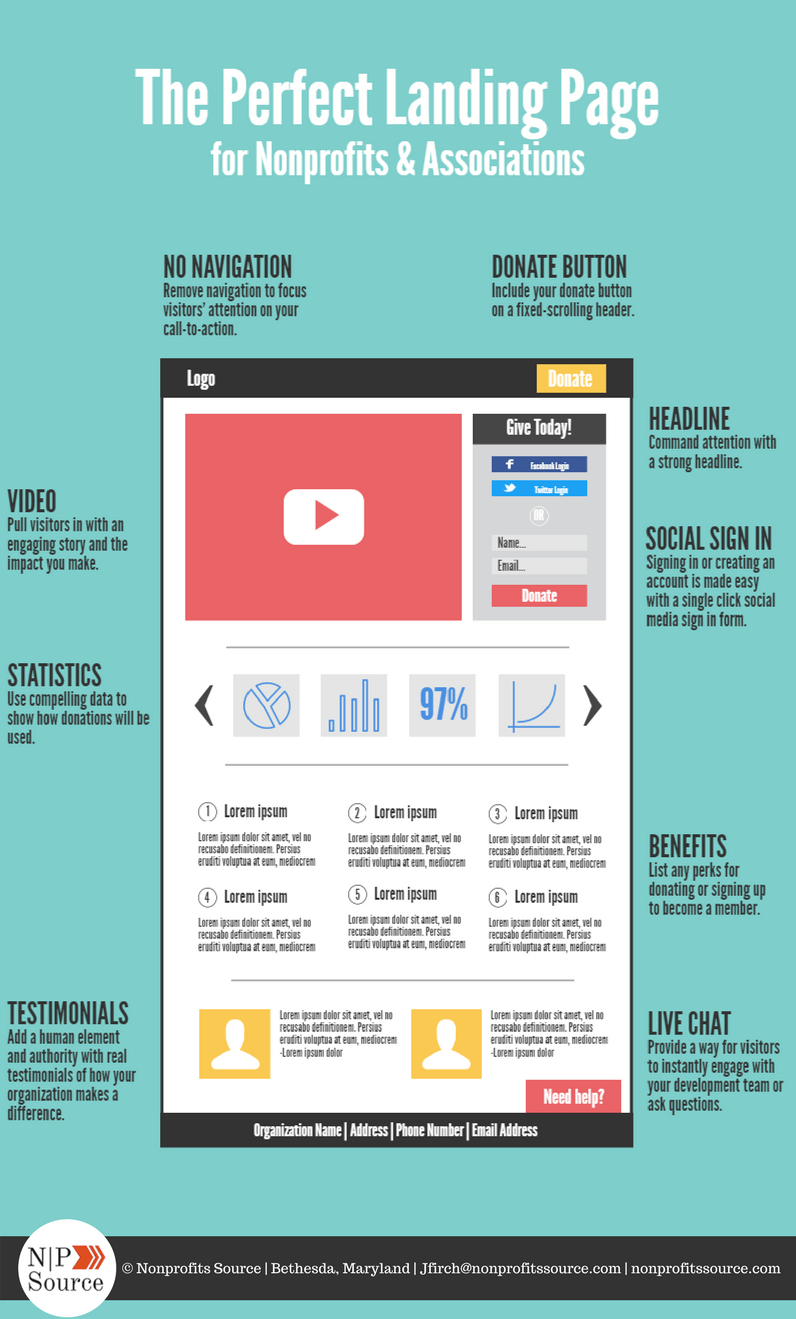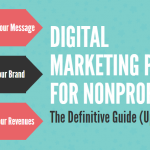15 Online Fundraising Ideas And Strategies (That Will Get Results)
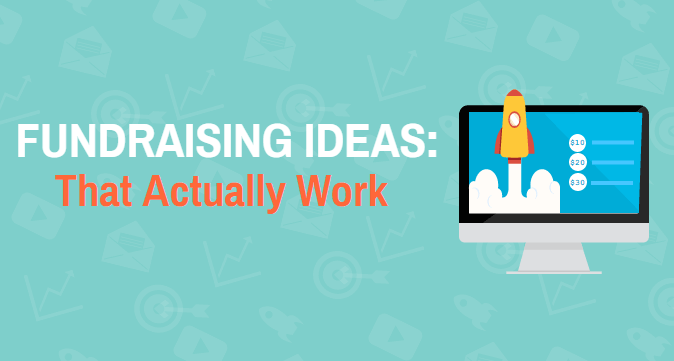
Are you looking for new ways to expand your nonprofit’s reach and spread awareness to your mission online?
Then you’re in luck!
Today I’m going to share 15 easy online fundraising ideas & strategies that actually get results.
Jump To A Fundraising Strategy Below:
1. Twitch Livestream
2. Facebook Audiences
3. Remarketing On Facebook
4. Engage With Live Chats
5. Exit Intent Popups
6. Donation Buttons
7. Online Donation Page
8. Monthly Giving Option
9. Financial Transparency
10. Secure Your Site (HTTPS)
11. Content Upgrades
12. Slide In Call To Action
13. Thank You Gift
14. Donors Choose Gift
15. Mobile Optimize Your Site
Online Fundraising Checklist: Don't have time to read the full article? Before you go, download our fundraising checklist, it's free!
The Current State Of Online Fundraising
The Information Age, along with the mobility of smartphones, has taken what idle downtime we once had to now being spent on an app, playing games, texting with friends, or sending emails.
In fact, we spend a majority of our waking hours connected online:
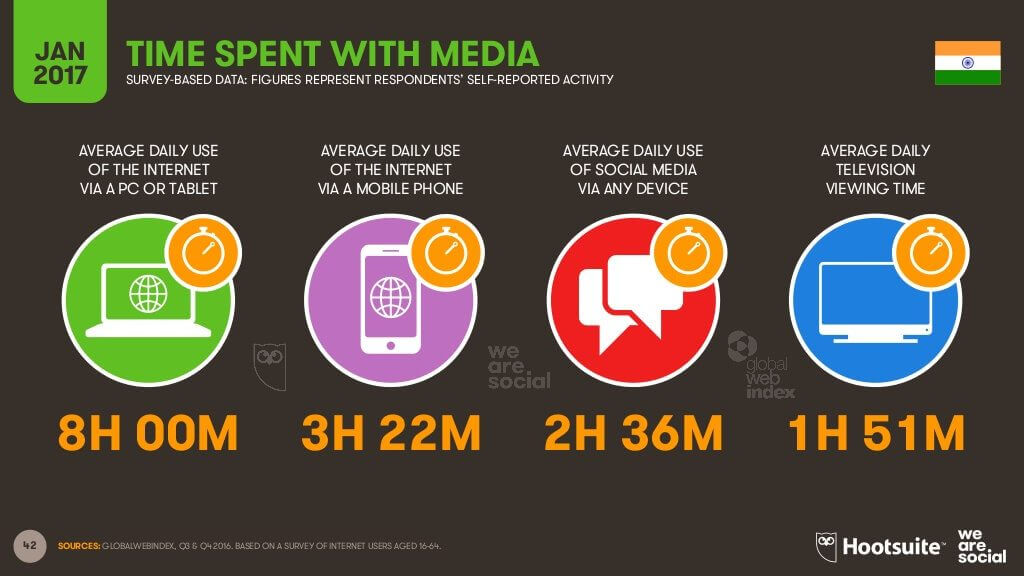
So how are we spending all of this time online?
Well, for 96% of Americans it’s shopping.
Our desire for convenience, lower prices, and larger selections has fueled the 16% growth in online shopping and the 100 million Amazon Prime Subscribers in America.
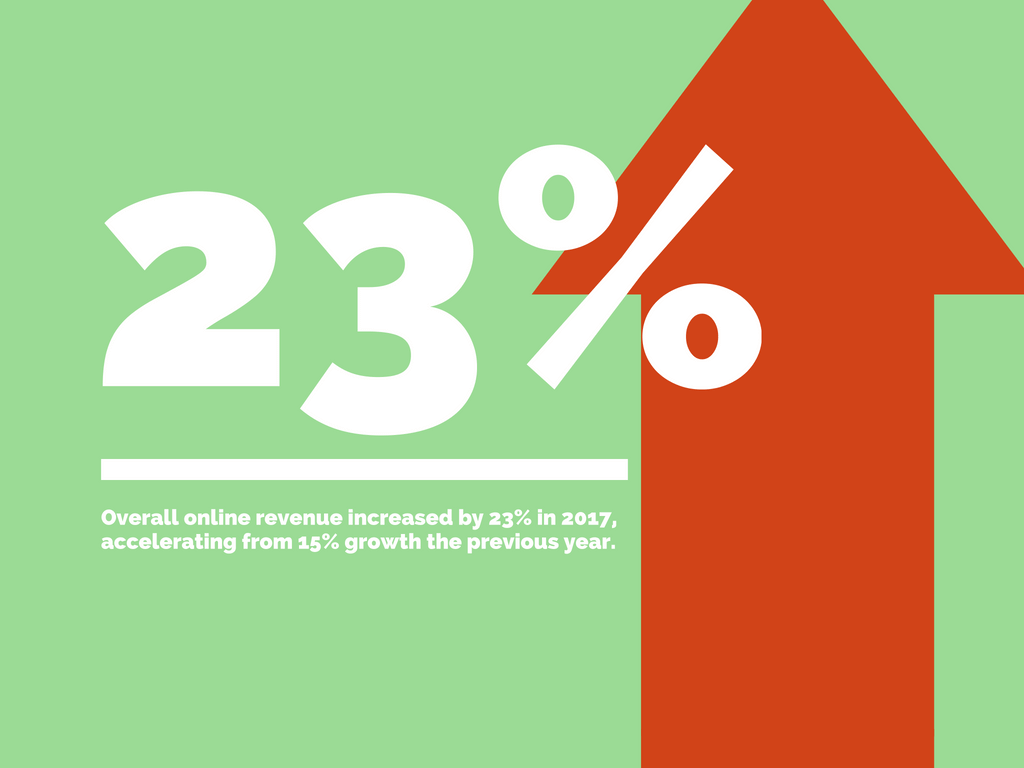
The online fundraising statistics are also clear – 6 straight years of growth:
- Overall online revenue increased by 23% in 2017, accelerating from 15% growth the previous year.
- Every sector tracked saw at least 15% online revenue growth, with particularly large gains for Environmental (34%) and Rights (37%).
- Nonprofits received an average of 28% more online gifts in 2017 than 2016.
As you can see, donor willingness is there, but that’s only the first part of the puzzle.
The other half is being found by your audience and that requires knowledge of the current digital landscape, which is undergoing a change of itself.
Additional Online Fundraising Statistics:
- On average, nonprofits raise 7.6% of their total revenue online.
- 30% of online giving occurs in December. 10% on the last three days of the year.
- Email accounted for 26% of all online revenue in 2017 and grew 15% over 2016.
- The average monthly donor will give 46% more in one year than those who give one-time gifts.
- In 2017, 21% of online donations were made on a mobile device.
- 66% of donors would use a mobile app that allows two-tap giving and earns badges and redeemable points. This app does not exist.
- Over the last 10 years, donor retention rates have been consistently weak – averaging below 50%.
- 66% of donors have volunteered within the last 12 months. 85% donated to the nonprofit that they volunteered for.
- The average online donation on #GivingTuesday is $120.40US.
- 45% of donors give to nonprofits located outside of their country of residence.
The Traditional Inbound Marketing Funnel Is Changing
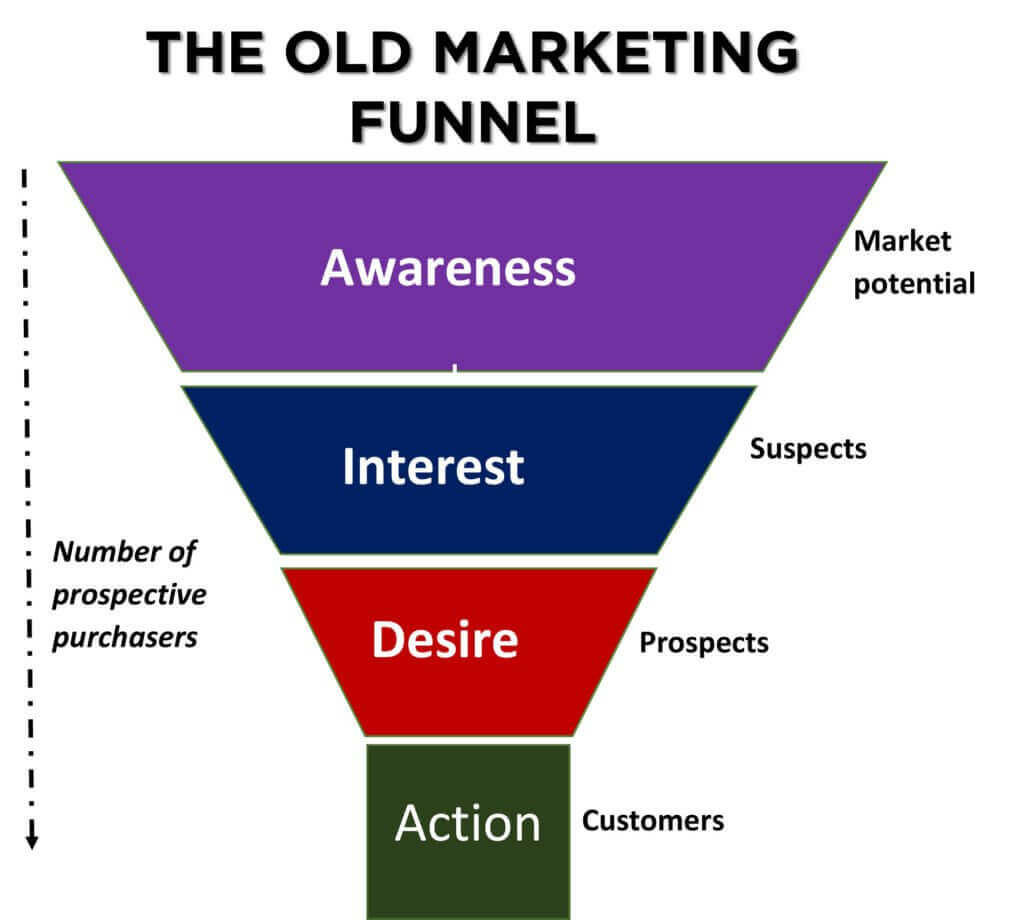
In the traditional inbound marketing funnel, we presume that someone who signs up for a newsletter or downloadable piece of content must also be interested in other offers.
So, you then bombard these new subscribers with email marketing funnels, retargeted ads, and pushy webinar registrations or sales calls.
I’m not saying these are bad tactics and that you shouldn’t use them, but rather that you should be more conscious of your audience’s needs over your own.
Here’s a good example of what not to do:
Pre-Checked Email Opt-Ins
A common tactic used by digital marketers when visitors signed up for an account was to pre-check a newsletter subscription opt-in:
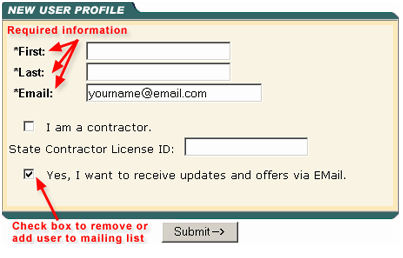
Whether you wanted to receive the newsletter or not, if this box remains checked you’ll start to get newsletter subscriptions and weekly emails for a tool you may or may not have even used.
Why did marketers use it?
Because it worked by growing email lists like crazy.
However, having a large list of new subscribers doesn’t necessarily provide the kind of ROI you might be hoping for.
I would say if out of 1,000 subscribers you had built a loyal fan base and following of 100 people that you would be knocking it out of the park.
However, a more likely outcome would be a handful of clicks and a swarm of unsubscribes and people asking why they were placed on a list they didn’t subscribe to.
Finally, there’s the legal consideration with the enactment of GDPR.
My recommendation for email marketing, in general, is that less is more.
The only time I reach out to my list is when I know I have something of value to offer.
Here’s an example of an email I sent explaining how I had added an update to a recent article with insight from fundraising experts:
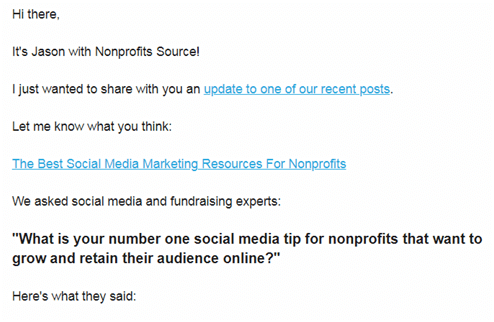
Subject: What is your number one social media tip for nonprofits?
Preview Text: Here’s what the fundraising experts are saying…
The results reinforce the importance of only sharing something of immense value that will satisfy your audience’s needs:
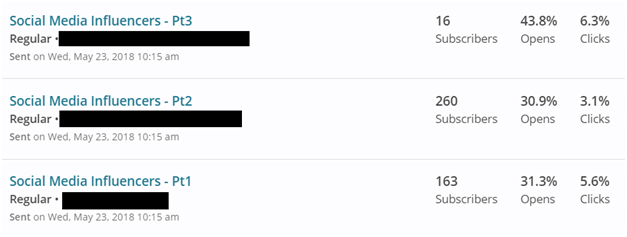
This is just one example of how inbound marketing is changing and where online fundraising is heading.
The Future Of Online Fundraising For Nonprofit Organizations
Let’s face it, we’re starting to get tired of landing pages and downloadable ebooks.
The newsletter subscriptions are piling up too since everyone is “doing” content marketing these days.
While the old ways of doing things do work they can come at a cost.
Having a negative online experience is enough to make someone reconsider their purchase, or in this case a donation.
Likewise, they are more likely to not recommend your organization to others.
A donor centric approach takes this into consideration by ensuring that at each point in your sales, marketing and onboarding process the customer’s needs are being met above all else.
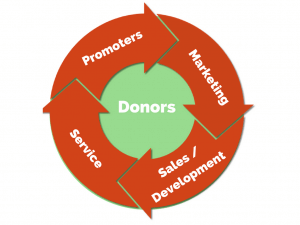
Donor Centric Flywheel
Marketing
The goal of any online marketing department is to provide as much value to the customer or donor as possible, and for free.
Trust has to be established before anyone is willing to buy from you. That trust takes time to develop and you have to give visitors a reason to want to consume your content in the first place.
Anyone can publish a blog online and establishing authority and an audience online is a long-term undertaking.
Do not look for your marketing to generate quick monetary results. Instead, encourage them to form meaningful relationships with members within the communities you serve.
This engagement will be the first steps towards retaining and growing your donor base.
Sales / Development
Your job isn’t to convince people to give to a cause, it’s to explain to the donor the value they are about to receive through their contribution.
Of course, you have to go beyond the email follow-ups and traditional call tasks to effectively reach potential donors.
For example, you could create a 30-40 second personalized videos to your top donors and explain to them exactly how their contributions have help made progress towards your goals.
Service / Impact
This is your moment to shine.
The area where you can show your worth and validate the investment made by your donors.
Throughout your engagement with donors, you need to take proactive steps to meet their needs.
Are you properly informing donors of progress or impact?
Do they clearly understand what it is you do and how you affect change?
Are you giving donors a reason (e.g. creating content) to want to visit your website and give to your cause?
It’s not enough to just remind them of your existence.
You have to go above and beyond their expectations by engaging with them as any other community organization engages with their members.
Promoters / Evangelists
You will eventually create a loyal audience who wants nothing more than to see you succeed.
When promoting new programs, services, offerings, or events consider reaching out to this network and ask them to share and amplify the message across their networks.
Word of mouth and brand evangelists are, to this date, one of the most effective forms of marketing.
In this case, the brand message is spread further through use of social selling.
Implementing Your Nonprofit’s Online Fundraising Strategy
I can’t say for certain that all, or even a single one of these fundraising strategies will work for you.
The thing with marketing is that the only way to know what works is to try it and find out.
Through experimentation, you begin to understand what channels your audience engages with you on the most.

Ideally, you’ll identify one strategy that outperforms in your group.
From there, allocate additional resources and time into the overperformers until those channels begin to mature.
Once you’ve matured audience growth move on to the next one and repeat the cycle.
I would also recommend choosing each strategy carefully to ensure they are working to achieve your marketing goals.
In addition, try not to focus on more than 2-4 strategies at a time otherwise you risk spreading yourself too thin.
1. Partner With A Live Streamer On Twitch
Did you know 78% of Twitch users reported wanting to see more charity in games?
Twitch.tv is quickly becoming one of the fastest growing and largest live streaming platforms on the web, with 15+ million daily active users and over 355 billion minutes watched in 2017.
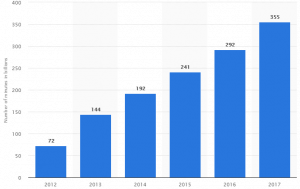
Nonprofits are taking advantage of these live streams as an opportunity to raise funds, grow awareness, and engage with donors in real time.
The Thirst Project ran a Twitch event on May 13, 2018 where 4,000 – 5,000 concurrent viewers gave over $30,000 in 12 hours.
Just crossed $30,000 for @thirstproject GET IN HERE 😀 https://t.co/g3fJwxrRus pic.twitter.com/yDKr6QS3rD
— Craig/Mini Ladd (@MiniLaddd) May 13, 2018
Update: July 17, 2018
After tweeting out to @ThirstProject to share their success they replied back saying the Twitch charity stream had actually raised $80,000 in 12 hours:
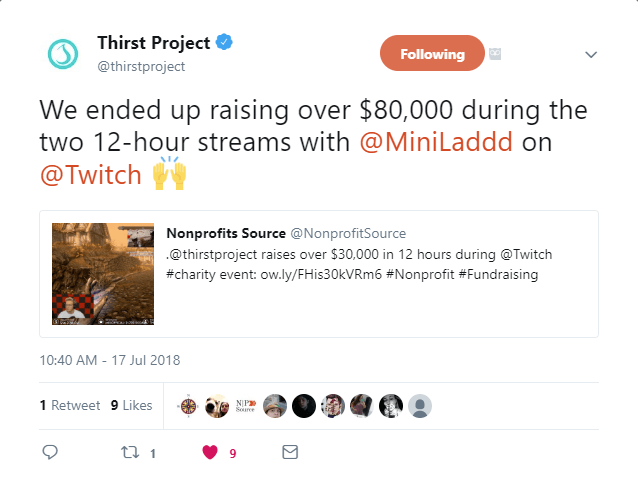
But wait, it gets better…
55% Of Twitch Users Are Between The Age of 18-34
Is your nonprofit searching for ways to engage with and attract the attention of younger generations?
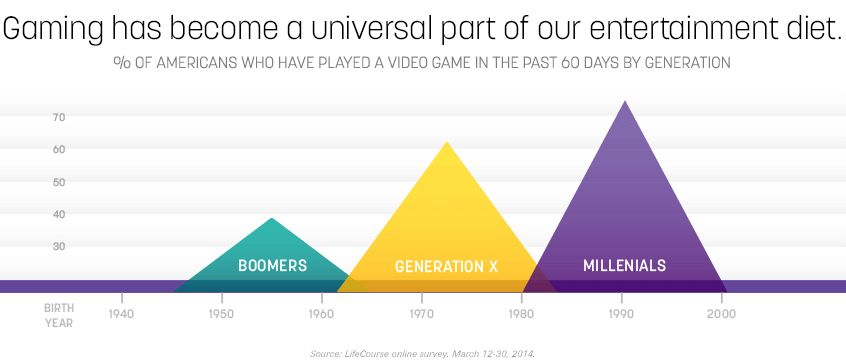
Then Twitch is THE platform for you:Video games are played by over 70% of Millennials and 60% of Generation Xers in America.
They also care deeply for the causes they support and are willing to spend enormous time and effort to ensure that nonprofits get the attention and funding they deserve.
The annual week-long online fundraiser event, Summer Games Done Quick (SGDQ), raised a total of $2,153,387 in June 2018, which is the first time it has surpassed the $2 million mark in its 8 year history.
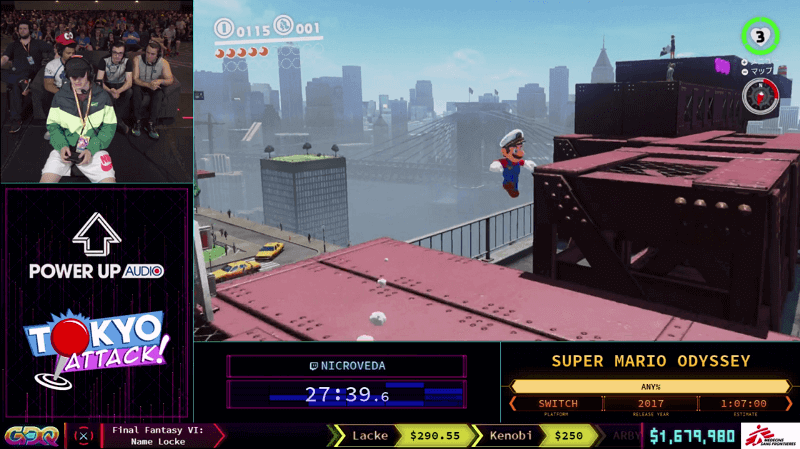
All proceeds benefit Doctors Without Borders, with an average donation size of $60.46.
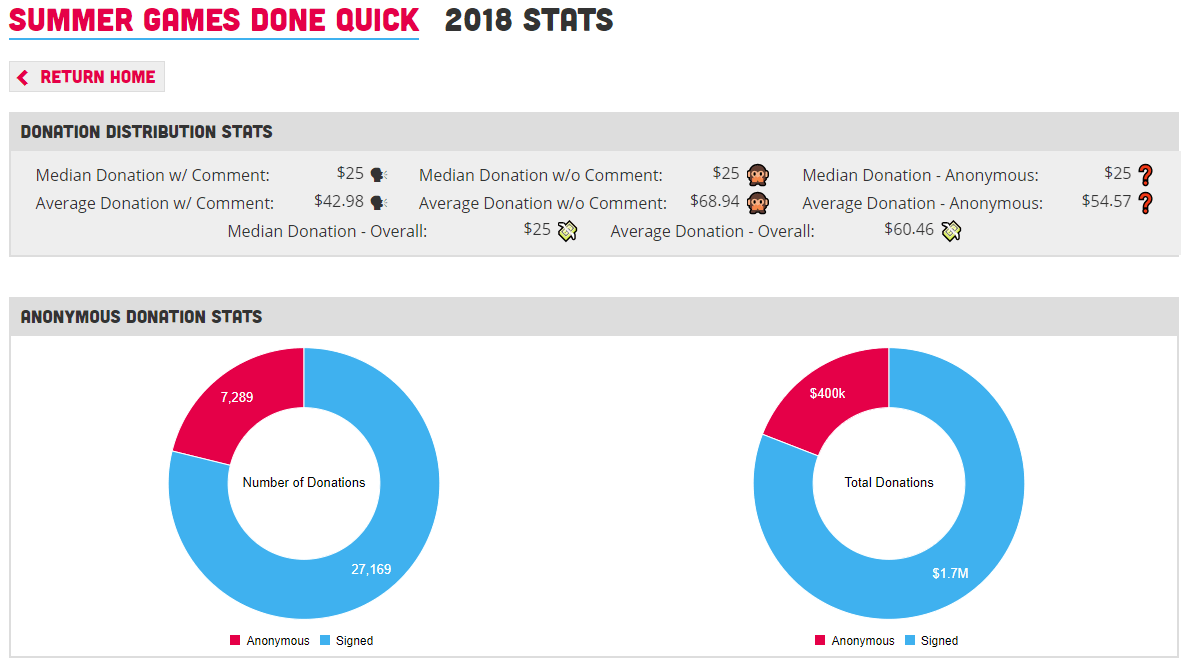
SGDQ has seen explosive growth (77.94% compounded over 8 year) since they began in 2011, much of which has been driven by the Twitch community and through partnerships:
Summer Games Done Quick Raises Over $2 Million In 2018
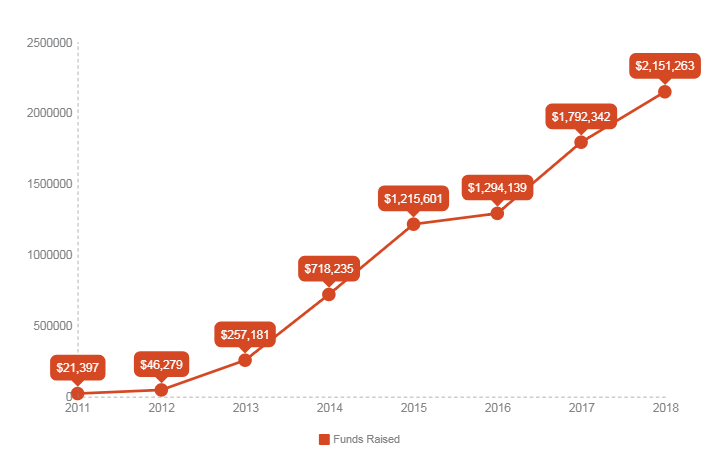
SGDQ’s History Of Online Fundraising Success:
- 2011 – $21,397
- 2012 – $46,279
- 2013 – $257,181
- 2014 – $718,235
- 2015 – $1,215,601
- 2016 – $1,294,601
- 2017 – $1,792,342
- 2018 – $2,151,263
Engage With Donors Online In Real Time
What’s unique with livestreaming is that you can engage with donors online and in real time.
The chat feature is extremely interactive with a number of opportunities to answer questions and address the issues your nonprofit faces.
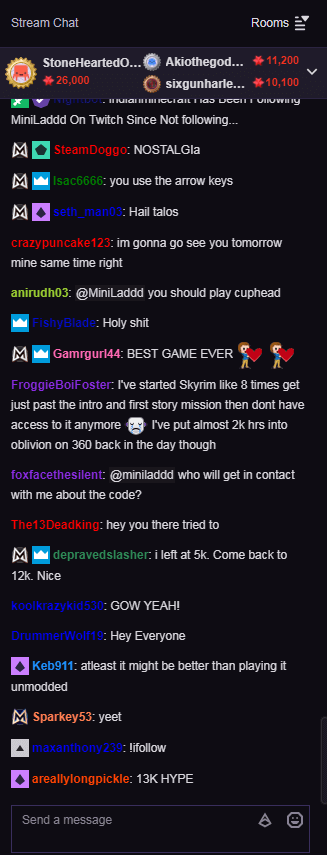
Next, people who donate are given a “shout out” along with an option to include a message to the streamer.
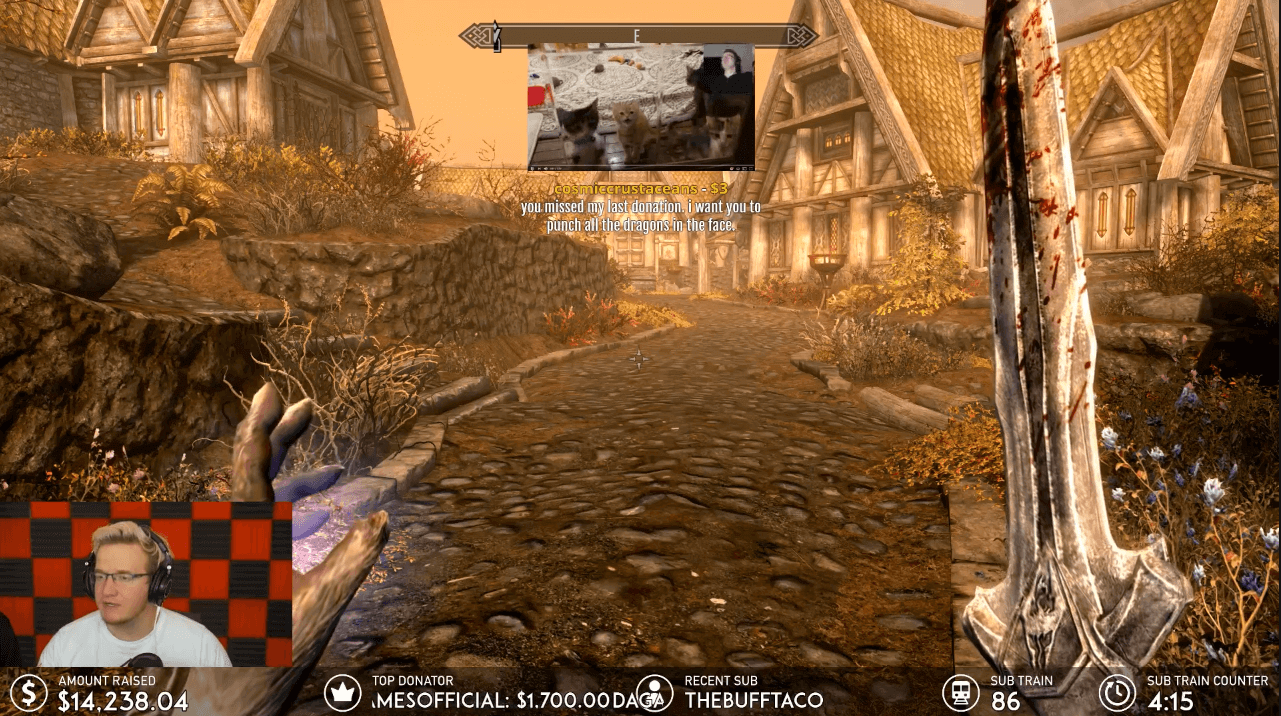
The message is then read aloud by a bot to the streamer and the audience.
The Donation Process Quick And Easy
The Thirst Project sent viewers to a donation page along with an option to include a message and a GIF.
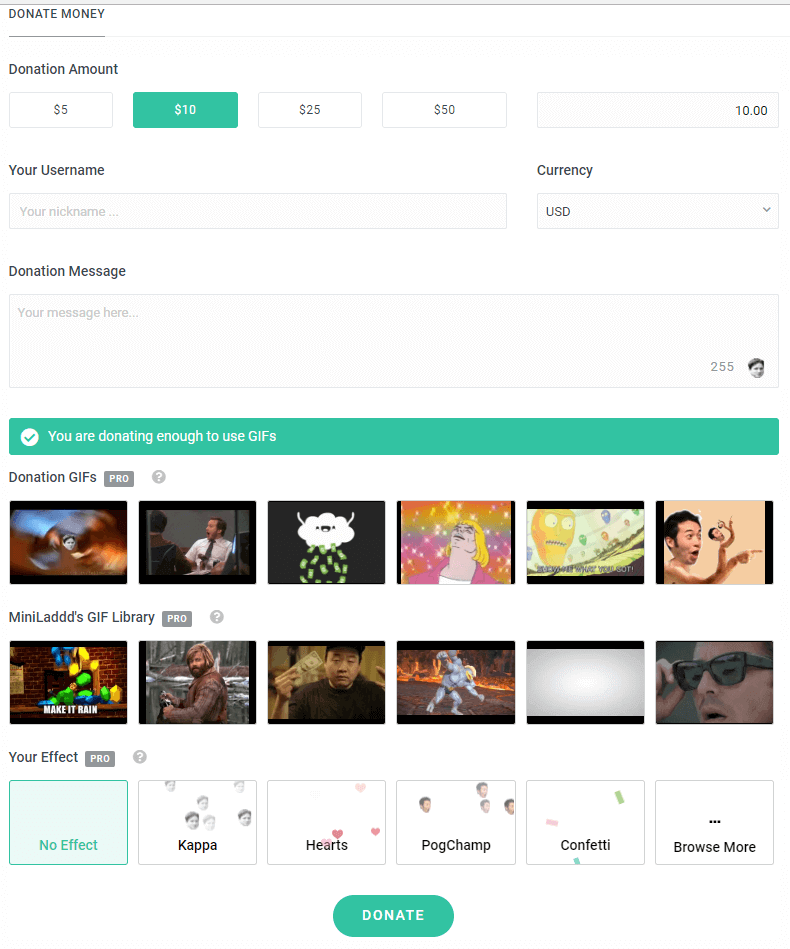
The gameification and competitive nature also create online “rivalries” where viewers attempt to out-donate their “opponent.”
In the case of SGDQ, they ran donation incentives, such as naming characters during the game or “unlocking” games to be played on stream.
In addition, donors were entered to win raffles for free giveaways.
Finally, they hosted a live Q&As with doctors from the Doctors Without Borders organization to discuss the impact they’re making in the communities they serve.
2. Custom Facebook Audiences
Result: 63% more donations, 55% higher conversion rate and a 2X ROI.
Custom Facebook audiences are an effective way to leverage your existing email lists.
They work by matching your database with Facebook, creating a custom audience.
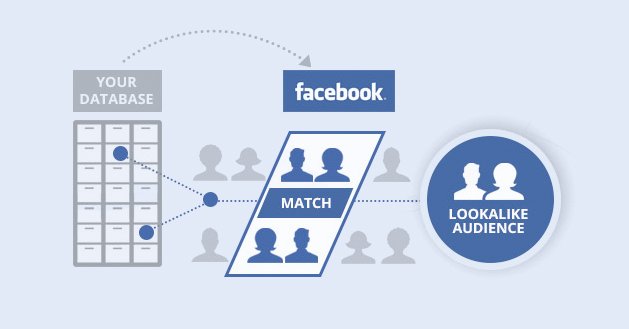
This means you can target Facebook ads to appear on the feeds of people who have donated to your nonprofit.
The Environmental Defense Fund (EDF) used this strategy during Giving Tuesday to maximize their year-end online fundraising.
By segmenting their lists and creating highly targeted Facebook Ads EDF:
- Grew their revenues by 63%
- Had a 55% increased conversion rate
- Saw a 2X ROI on ad spending
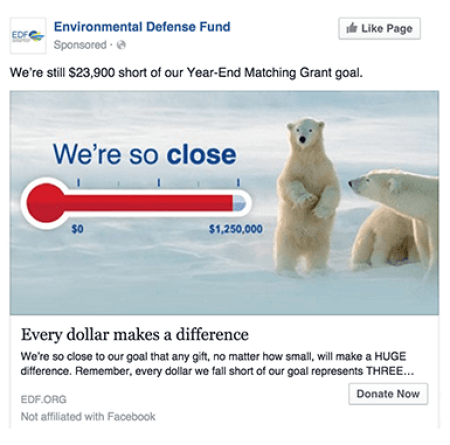
Instead of uploading their entire list, EDF first segmented it into 2 groups:
- Giving History
- Environmental Activists
Each group was then further segmented into 3 separate audiences:
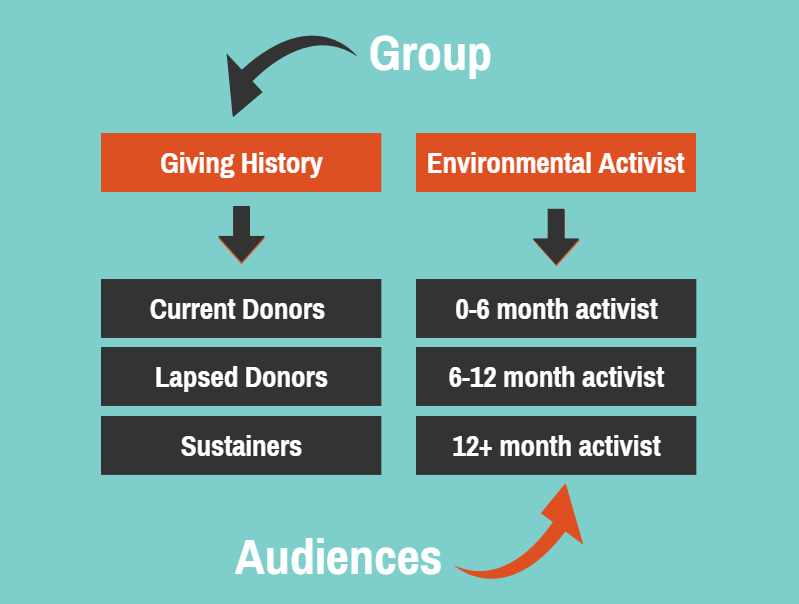
Giving history divided donors into:
- Current donors: Members who have donated in the past year
- Lapsed donors: Members who have donated, but not in the last year
- Sustainers: Members who make monthly donations
Environmental activists divided donors into audiences based on time spent as an activist:
- 0-6 month activist
- 6-12 month activist
- 12+ month activist
Once the list was segmented, a custom Facebook audience was created for each group.
Next, EDF created ad copy that was relevant to each audience and their personal relationship with the nonprofit.

By using Facebook’s donation button with a $3-for-$1 match offer, EDF was able to further maximize donations.

Here’s how you can quickly create a custom Facebook audience for your fundraising campaigns:
First, head over to your Facebook ad manager and select the “Audiences” tab.
Then click the “Create Audience” drop-down and select “Customer File.”
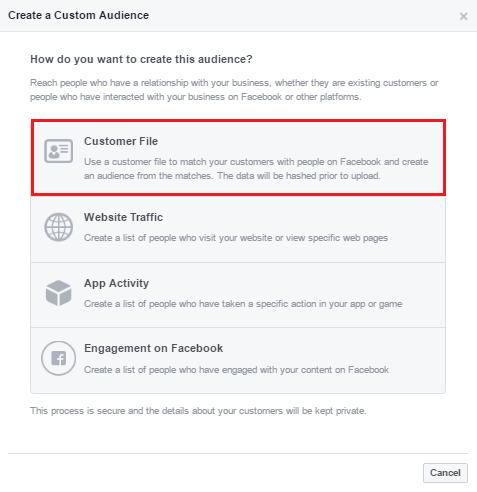
Next, choose either a .CSV file or MailChimp list to import.

When you provide your list, Facebook takes that information and compares it against their database using up to 15 identifiers.

These identifiers then match your information to donor Facebook profiles.
You can also expand your reach by creating lookalike audiences, who are people that share common qualities with your target audience.

For example, individuals who have donated to a nonprofit in the last 12 months.
That’s it.
When you’re ready to create a Facebook Ad just select your new custom audience to target.
3. Remarketing On Facebook
Result: 119%-203% higher conversion rates.
Content is still a very important factor in educating, informing, and building member/donor trust.
47% of donors say they consume 3-5 pieces of content prior to engaging with a sales/development person.
But getting your content in front of your target audience can be difficult.
This is where remarketing comes into play.
Remarketing helps you reach people who have previously visited your website or used your app.
It gives you the opportunity to customize follow-up messages, provides a different form of engagement, as well as an additional avenue to promote your content in front of an audience already familiar with your work.
The marketing process looks something like this:
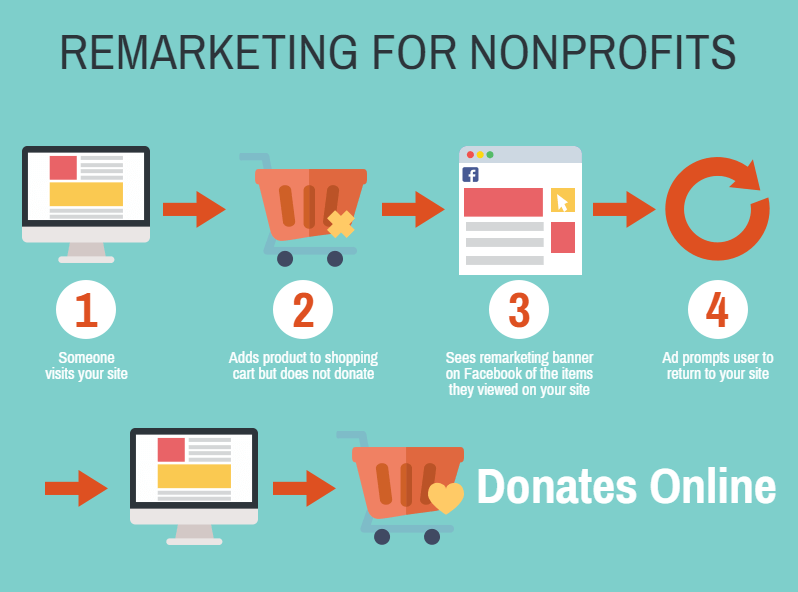
The research supporting remarketing is compelling:
- 70% of website visitors who are remarketed to are more like to convert on your website
- 72% of online donors are likely to abandon their shopping cart prior to completing a purchase
- Without remarketing, only 8% will return to complete the purchase
- With remarketing, 26% return and complete the checkout process

Sign Up For Free Marketing Tips
Do you use digital to grow awareness to your mission? Sign up and get the latest posts on digital marketing for nonprofits.
In some cases, organizations saw between 119% and 203% increase in overall conversions.
To test the theory, I recently ran a remarketing campaign on Facebook promoting my article, “How To Get More Online Donations With Content Marketing.”
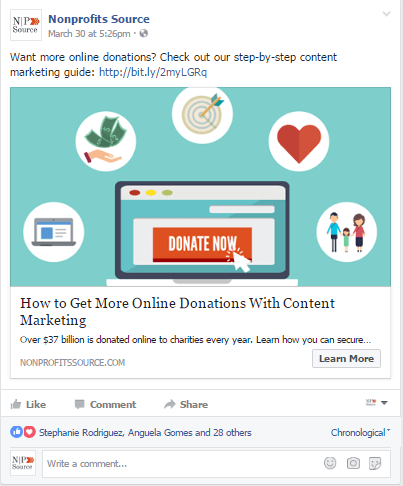
I ran the ad between March 12, 2017 and March 16, 2017 with a daily budget of $50.00.
The results were SHOCKING:
- 15,227 people reached over 4 days
- 522 clicks to my site at a cost of $0.29 per click
- Average click-through rate (CTR) of 3.4%
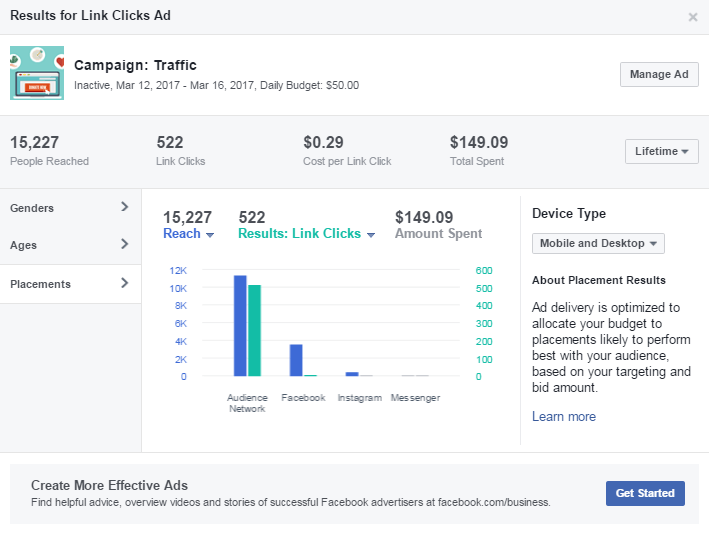
When compared to a non-remarketed ad I ran for my article, “5 Biggest Nonprofit Marketing Mistakes (And How To Avoid Them),” my conversions (clicks) increased by 10X.
From an economic standpoint, the potential ROI is amazing.
It would only take 15 out of the 522 clicks (a 2.9% conversion rate) to donate $10.00 each to recoup the cost of the ad.
Not bad when you consider the average online donation is $104.00.
Even better, setting up a remarketing campaign on Facebook is extremely simple:
First, you’ll need to set up a tracking code on your site.
This tiny bit of code makes it possible to retarget your offer, brand, or other online fundraising ideas to people who have previously visited your site.
It works by adding a cookie to the web browser of the visitor.
These cookies are assigned unique identifiers to each visitor to ensure relevant ads are being shown.
When an opportunity comes to show your ad in front of a visitor, the chosen platform (Facebook, Twitter, Google, etc.) will look for the cookie to place it in front of the appropriate audience.
Note: Be sure to have a remarketing privacy policy visible on your site to inform visitors of how you may be using their information.
To add this code you’ll need access to place the script in the header or footer tags of your website.
If you have a developer they can set it up in as little as 10 minutes.
Here are a few guides for popular sites to get your tracking codes set up:
- Google Remarketing Tag
- Facebook Pixel
- Pinterest Tag
- Twitter Conversion Tracking
- LinkedIn conversion tracking
Next, you’ll want to create a new custom Facebook audience targeting recent visitors to your site.
Under the Audiences tab in your Facebook ad manager, click the drop-down on “Create Audience” and select Custom Audience -> Website Traffic.
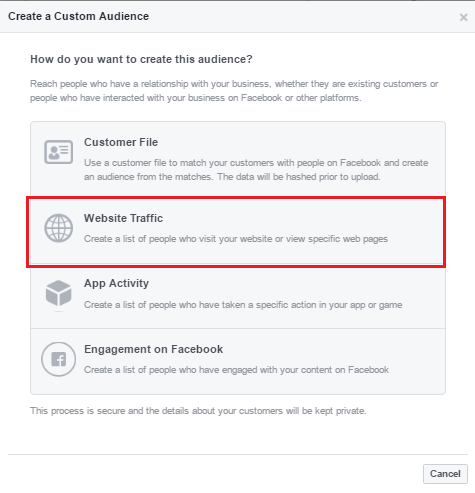
Here you’ll be given the option to create an audience based on people who have visited your site.
You can take this targeting one step further by only selecting people who have visited specific URLs.
For example, your homepage, donation page, or other online fundraising pages:
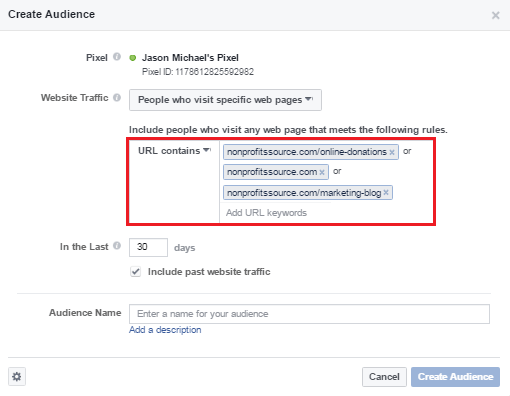
Once you have all of the criteria set you can create the audience to be used in your next Facebook ad.
4. Use Live Chats To Engage With Donors
Result: 45% increased conversion rate.
If there’s one thing in marketing that will never go out of style, it’s a personalized experience.
Imagine the impact of your online fundraisers if your development team could instantly answer questions or assist in the donation process.
That’s exactly what WorldHelp had in mind when they used a live chat to lift conversions by 45%:
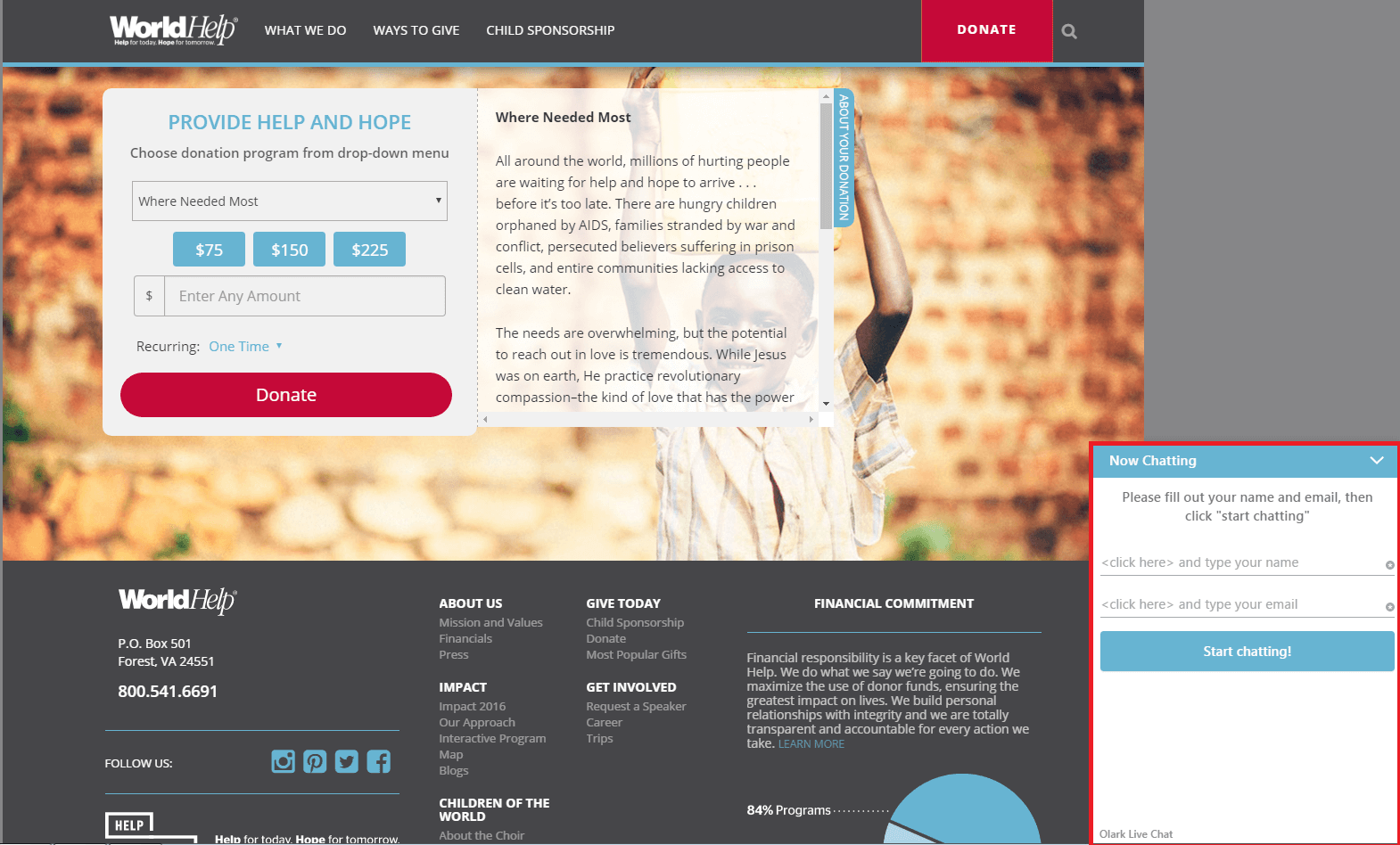
Here is why live chats are so effective at maximizing donations:
- It replaces phone or email communication with real-time support directly on the website
- Validates the entire experience and improves credibility of the organization
- Your development team can “upsell” by promoting fundraising events or membership only benefits
- Provides an opportunity to contact every person browsing your site
- Real-time visitor tracking data and analytic reporting tools
Furthermore, a report conducted by emarketer.com found that 63% of visitors are more likely to return to a website that offers live chat.
When it comes to choosing a live chat platform for your nonprofit there really isn’t a bad choice.
Each offers unique customization and reporting capabilities while being able to support multiple users.
The cost is manageable with most plan levels starting between $10.00 and $39.99 per month.
Best of all it’s easy to get started, with the set up only taking 10-15 minutes.
I would recommend testing out some of the feature sets to maximize the success of your fundraising ideas.
For example, you could test a chat window that automatically pops up after a set time offering to answer visitor questions.
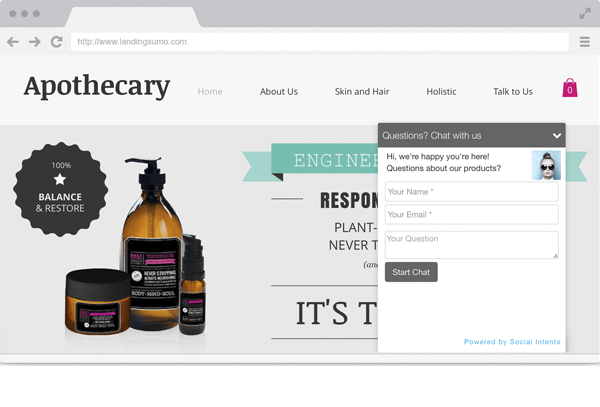
The thought is:
If a visitor is willing to spend 1 – 2 minutes on your site, then they might be interested in chatting with a representative from your organization to learn more.
From a branding perspective, you can set your own logo and colors, as well as create team member avatars.
The reporting tools can also be helpful by saving user history to show frequency of visits, time spent on site, which pages they visit, and how they landed on your website.
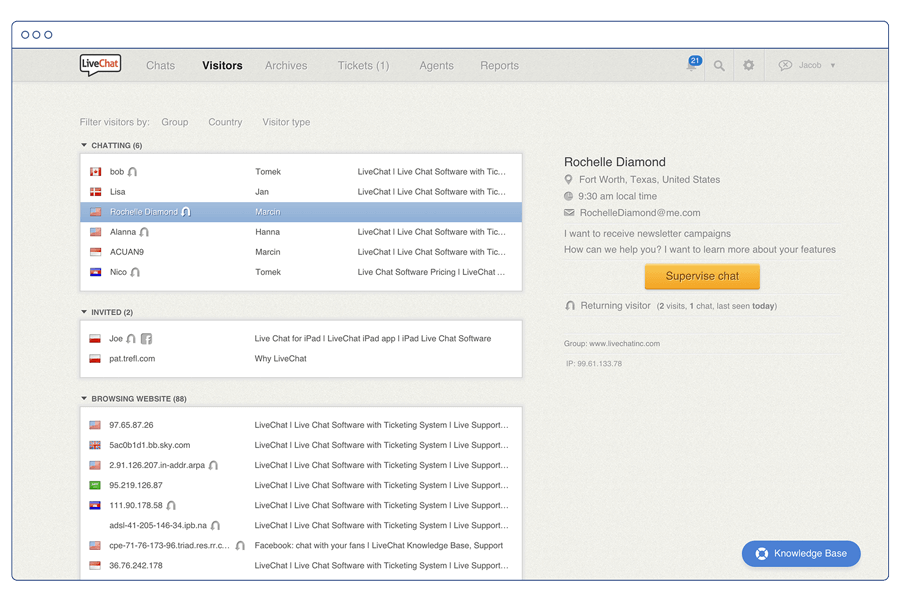
By requiring visitors to fill out an opt-in form to chat, you’ve also created a new method of growing your email list.
Bottom line, live chats are inexpensive, easy to set up, and can drive donations to your site.
5. Grow Your Email List With Exit-Intent Popups
Result: 100%-600% increase in email opt-ins.
Popup windows are annoying, intrusive, and create an overall bad end user experience.
Nothing is worse than when you’re halfway through an article and this happens:
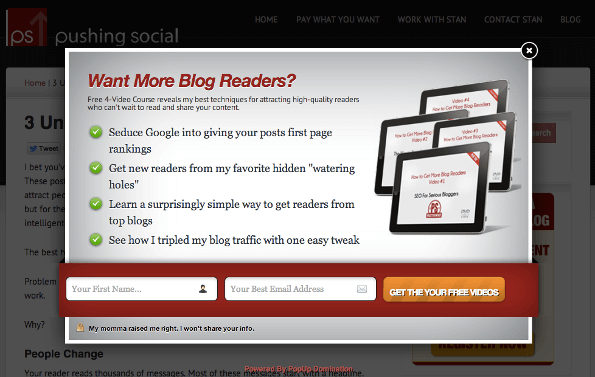
You’re probably wondering:
“If popups might cause potential donors to leave my site, then why should I use them?“
It’s simple.
Because they are extremely effective at converting visitors into leads.
Unlike normal popups that appear after a set time, exit-intent popups only trigger when the user attempts to leave the page.
Here’s how one website uses an exit-intent popup to increase email subscriptions by 100%:
ManyBooks, which provides free online eBooks, wanted to implement a solution that would grow their email list.
What better way to do that then to use an exit-intent popup on their blog.

The popup was so successful for ManyBooks that they were able to grow their email list to over 150,000 subscribers:
The idea behind using an exit-intent vs a traditional popup window is that visitors who are going to leave your website will leave anyways.
According to industry research, 10%-15% of lost visitors can be “saved” by using exit-intent popups.
Providing another opportunity to engage with potential donors and increase the success of your fundraising ideas.
Still not convinced?
WPbeginners saw a 600% increase in email subscribers using exit-intent popups.
You might be thinking:
“I don’t want to upset my current donors or members with popups.“
WPbeginners had the same concerns, initially.
After conducting a split test to track bounce rates and visitor complaints, they proved exit-intent popups had no negative impact on their audience.
In terms of lead generation platforms, for WordPress sites, Thrive Leads is the go-to plugin.

Sign Up For Free Marketing Tips
Do you use digital to grow awareness to your mission? Sign up and get the latest posts on digital marketing for nonprofits.
It’s affordable at $19.00 per month and has TONS of customization options.
You can even connect the lead captures directly to a mailing list provider, like MailChimp.
For A/B split testing, the dashboard provides impression and click-through metrics to maximize conversion.
If you’re not using WordPress, then I’d recommend you check out any of these platforms:
One last point about exit-intent:
Get creative.
Sometimes graying out the “no” button or having a catchy headline can dramatically increase conversion rates.
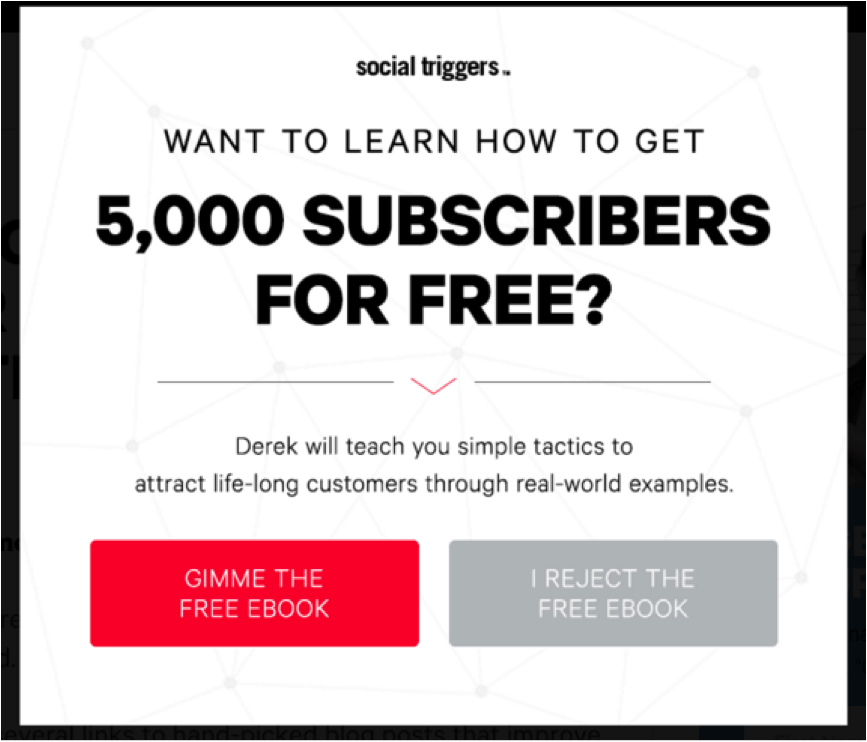
6. Make Donation Buttons Relevant Visible And Accessible
Result: 2X email opt-ins and 71% increased conversions.
Placing a static donation button or email opt-in form on every page of your website has become standard practice for nonprofits.
But why are they so effective?
Because people are persuaded to take action by engaging with different types of information.
For example, a visitor may be more likely to donate when they see scientific evidence or data.
On Paws Chicago’s homepage they use data to show how their organization has made an impact on their cause since their founding:
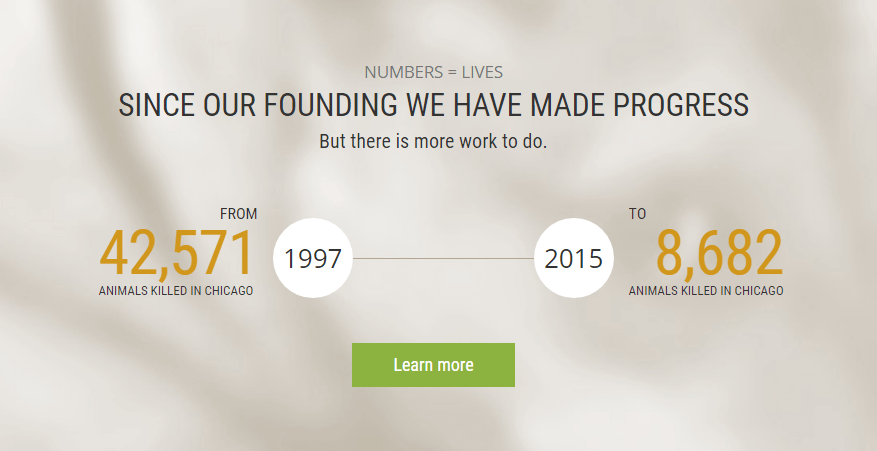
Others might be swayed by testimonials, case studies, or even interactive content.
Regardless of what triggers a visitor to take action, having a visible donation button, email opt-in form or relevant CTA is crucial to increasing conversions.
ONE uses a floating sidebar to capture more email opt-ins.
They also change the sidebar CTA to be relevant to the topic of their posts:
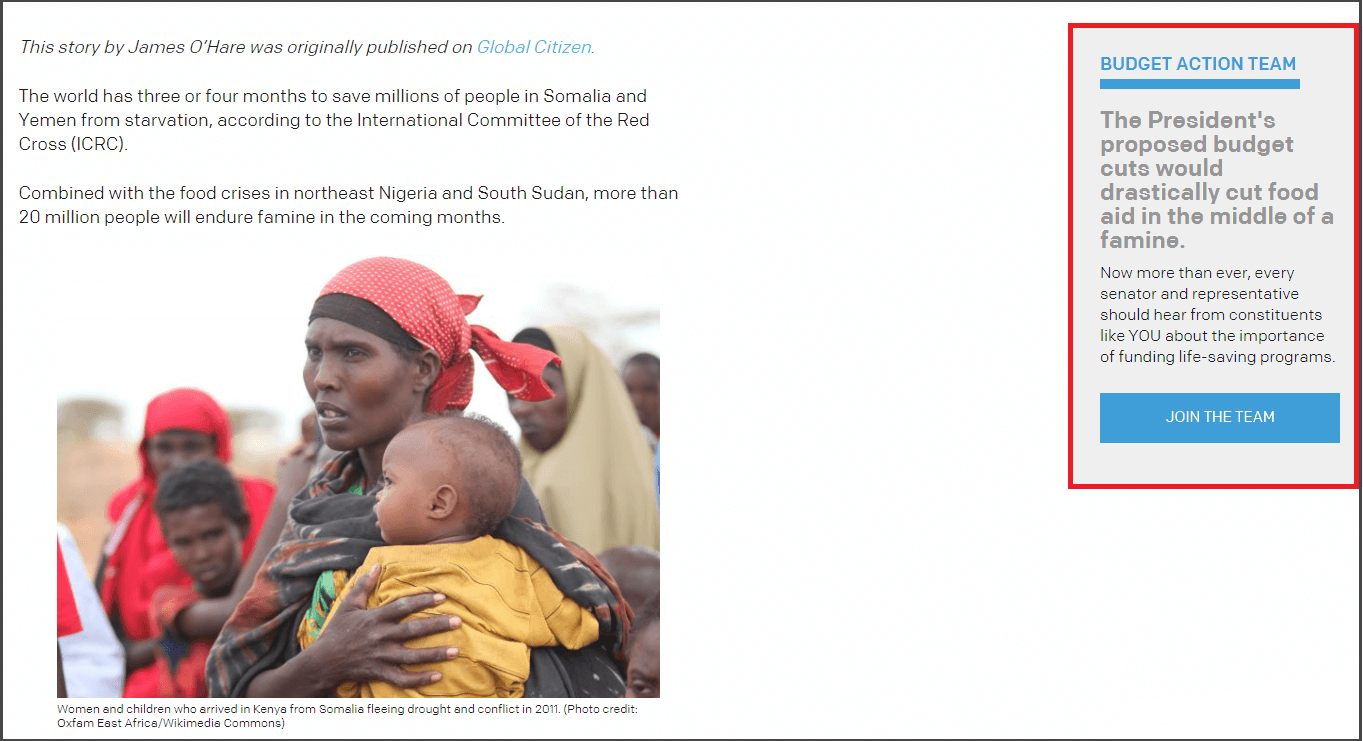
Which then takes visitors to a simple landing page to capture lead information for their online fundraising campaigns:

What are the results?
Nearly a 2X increase in email opt-ins
Another way to increase conversions by up to 71% is to include an email opt-in within the text of your posts.
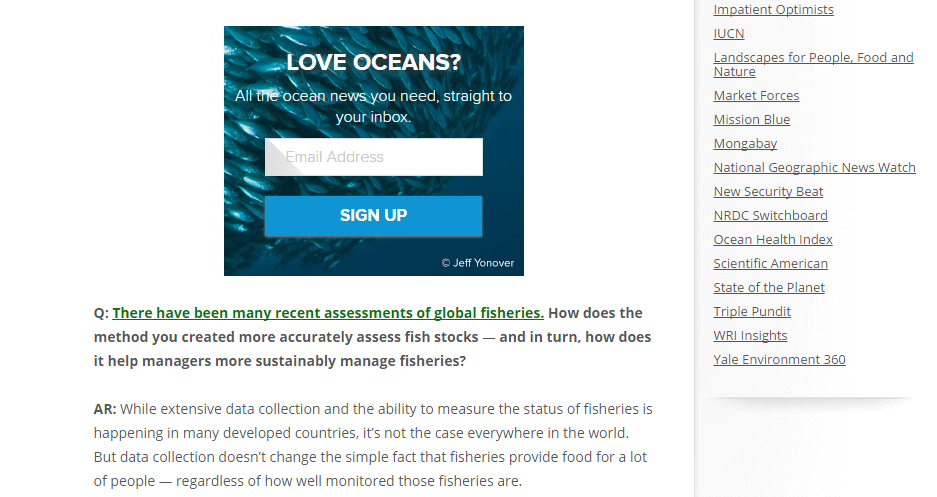
Conservation International makes a point to include an email opt-in within the body of every blog post.
Depending on the topic of the post the headline and call to action changes:
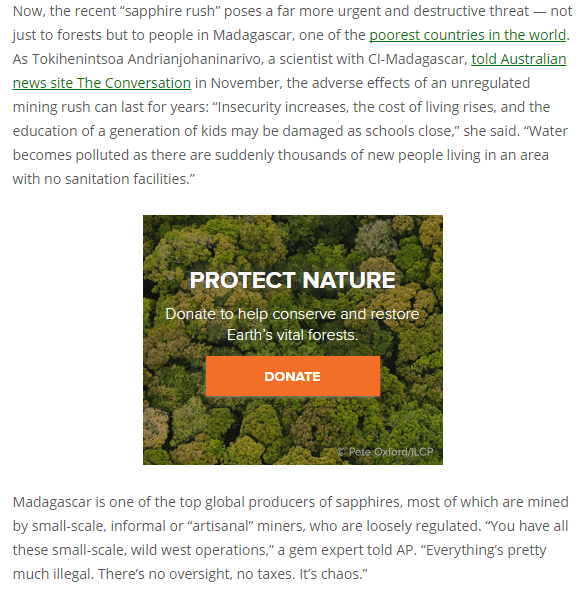
7. Optimize Your Online Donation Pages
Result: 77% higher conversion rate.
Landing page optimization isn’t a new concept, but it can be a little misunderstood.
Just take a look at how landing pages are performing across all industries:
- The average conversion rate for a landing page is 2.35%
- The top 25% convert at 5.31%
- And only the top 10% see above an 11% conversion:
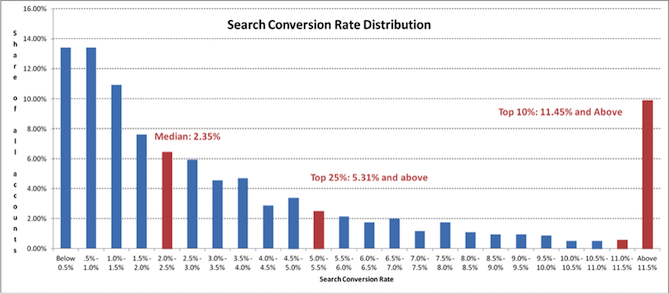
So why is there such a large gap in conversions between average landing pages and the top 10%?
They’re optimized for user experience.
Making even the slightest changes can have a BIG impact, increasing conversion rates by 77%.
If you’re promoting a webinar, conference, donation page, or other fundraising ideas then check out the perfect landing page for nonprofits & associations:
One of my favorite optimization tactics used on this page is the social sign in.
This feature has been known to increase conversions by 10% – 60% because it only requires one action (a click) to login or create an account.
In other words, you’re providing visitors with an easier option for signing in.
As always, A/B test your landing pages for every fundraising campaign or you could miss out on boosting your unique fundraising ideas by 162%.
When it comes to A/B testing your landing pages I would suggest looking into any of these platforms:
8. Ask For Monthly Gifts By Default
Result: 500% increase in online donations.
Donors that set up recurring donations give 42% more annually, compared to one-time donations.

When you do the math, that impact can be even greater:
The average online one-time gift across sectors is $104.00, while the average online monthly gift is $52.00.
That’s a 500% increase over a one-time gift, assuming the donor gives monthly for an entire year.
The Human Rights Campaign promotes a monthly gift by default on their donation page (and for good reason):
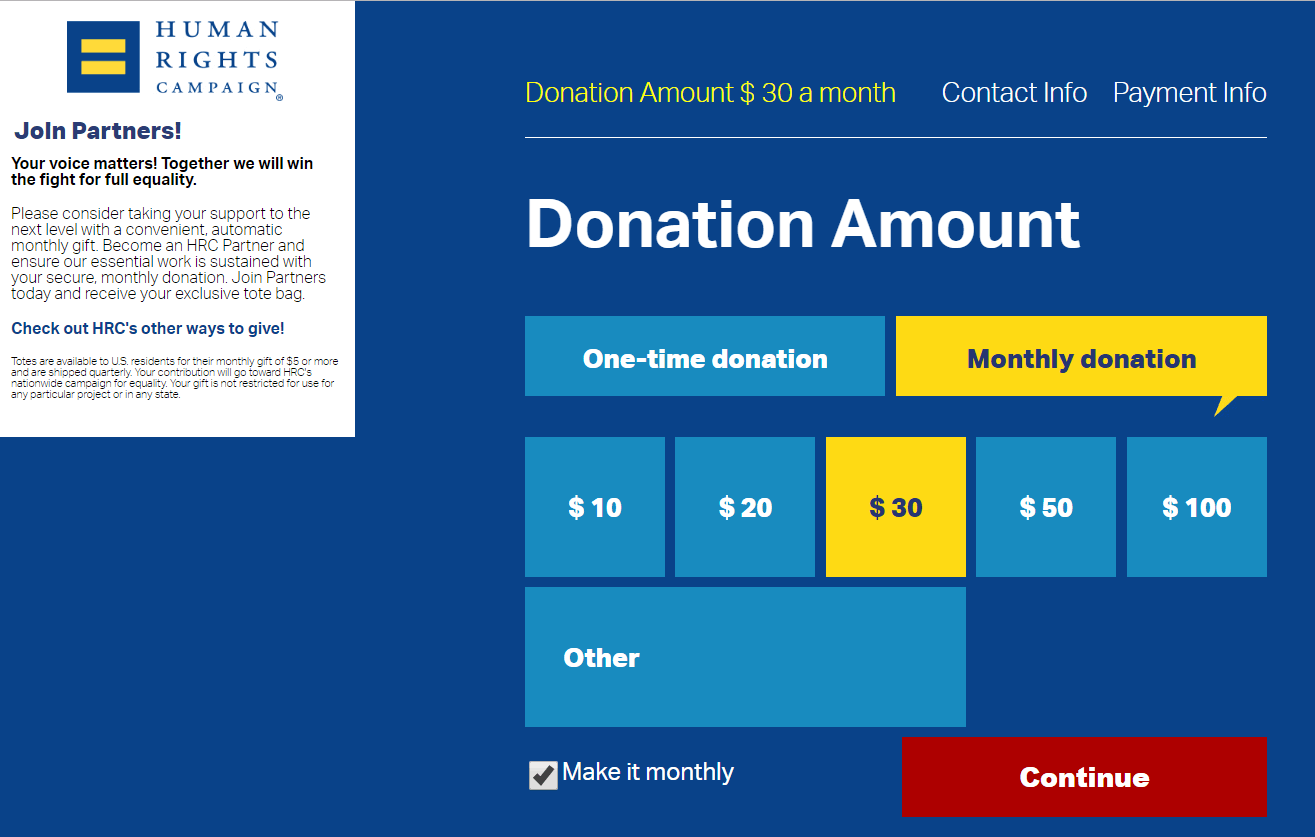
These pre-selected fields make a big difference, increasing conversions on monthly donations by up to 35%.
While monthly donations are extremely helpful for preserving cash flow, it’s important to keep track of donor retention rates.
One way to ensure donors continue to give monthly is by using a lead nurturing email marketing strategy.
These campaigns send a series of automated email workflows based on conditioned triggers; typically promoting content to push visitors down a buyer/donor journey:
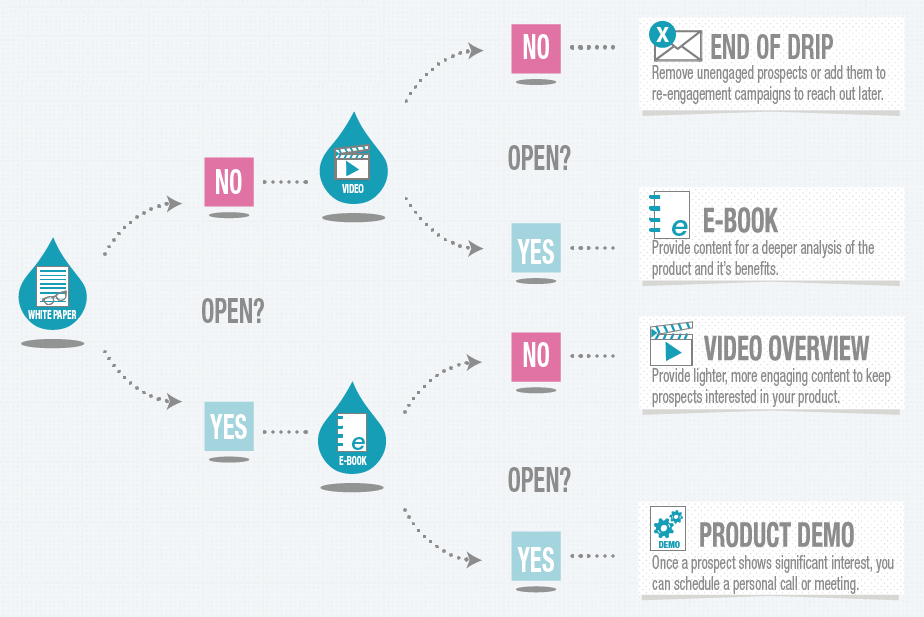
Just how effective are these lead nurturing emails?
- Nurtured leads make 47% larger purchases than non-nurtured leads
- Lead nurturing emails get between 4 and 10 times the response rate
- On average, 15% to 20% of the “not yet ready to purchase” leads converted into revenue
By continuing to offer content to donors, you’re reminding them of why they invested in your organization.
9. Show Donors Financial Transparency
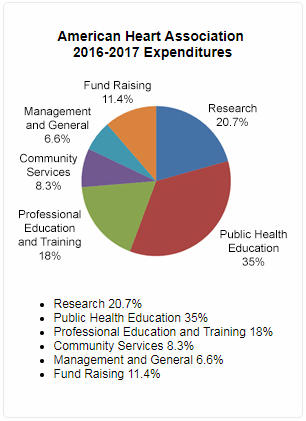
Result: Donors gain clear understanding of how their contributions are being spent.
Build donor and member trust by including transparent financial information your donation/landing pages.
Financial data can compel action from visitors when showcasing the outcomes your nonprofit has achieved.
For example, include a breakdown of the percentage of donations that go towards your organization’s mission.
10. Secure Your Site With HTTPS
Result: Compliance and develop audience trust.
In August of 2014 Google announced HTTPS as a ranking signal as the search industry moves to securing websites and those who visit them.
According to an industry study, more than half of all first page results are HTTPS with that figure expected to continue its climb in 2018.
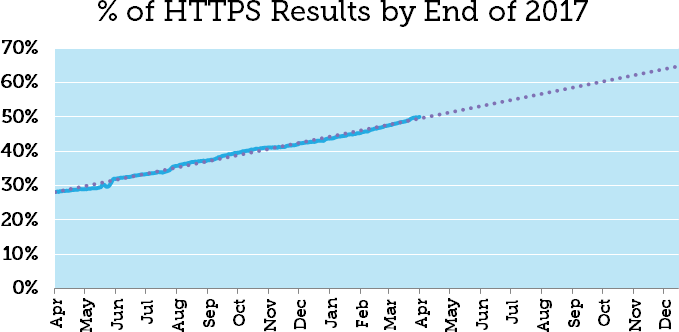
While there are other methods for securing your website, HTTPS is considered to be the basic minimum requirement.
This is especially true if you collect online donations or payments and require PCI (Payment Card Industry) compliance.
With this additional layer of defense you’re able to better safeguard donor payment information, rank higher in search results, and build trust with your audience.
Here’s how to successfully apply an SSL certificate to avoid Google penalties:
- Ask your web developer or hosting provider (NameCheap, GoDaddy, Bluehost) to install a domain name SSL certificate. Cost: $25.00-$40.00/year.
- You’ll know the certificate was successfully applied if the browser says your site is secure.
- Make sure to redirect all web pages from HTTP -> HTTPS to avoid duplicate content issues and a Google penalty.
- Make sure to include the https:// version of your domain in the sitemap and Robots.txt file.
- For WordPress users, I recommend Really Simple SSL, which automatically sets all of your redirects and resources to https://.
11. The Content Upgrade
Result: 785% increase in email list growth.
First, create a piece of gated content that is both relevant to the article and enhances it’s value to visitors.
Online Fundraising Checklist: Don't have time to read the full article? Before you go, download our fundraising checklist, it's free!
For example, if you publish a post of the top 10 social media tips for nonprofits, then you could create a content upgrade of a checklist that includes 2 additional tips not found in the post.
Next, create a CTA that is visible at the top of your site and within the body of your article.
Finally, use a unique lead nurturing email workflow for these new subscribers to get them to take a favorable action.
12. Use A Slide-In Call To Action
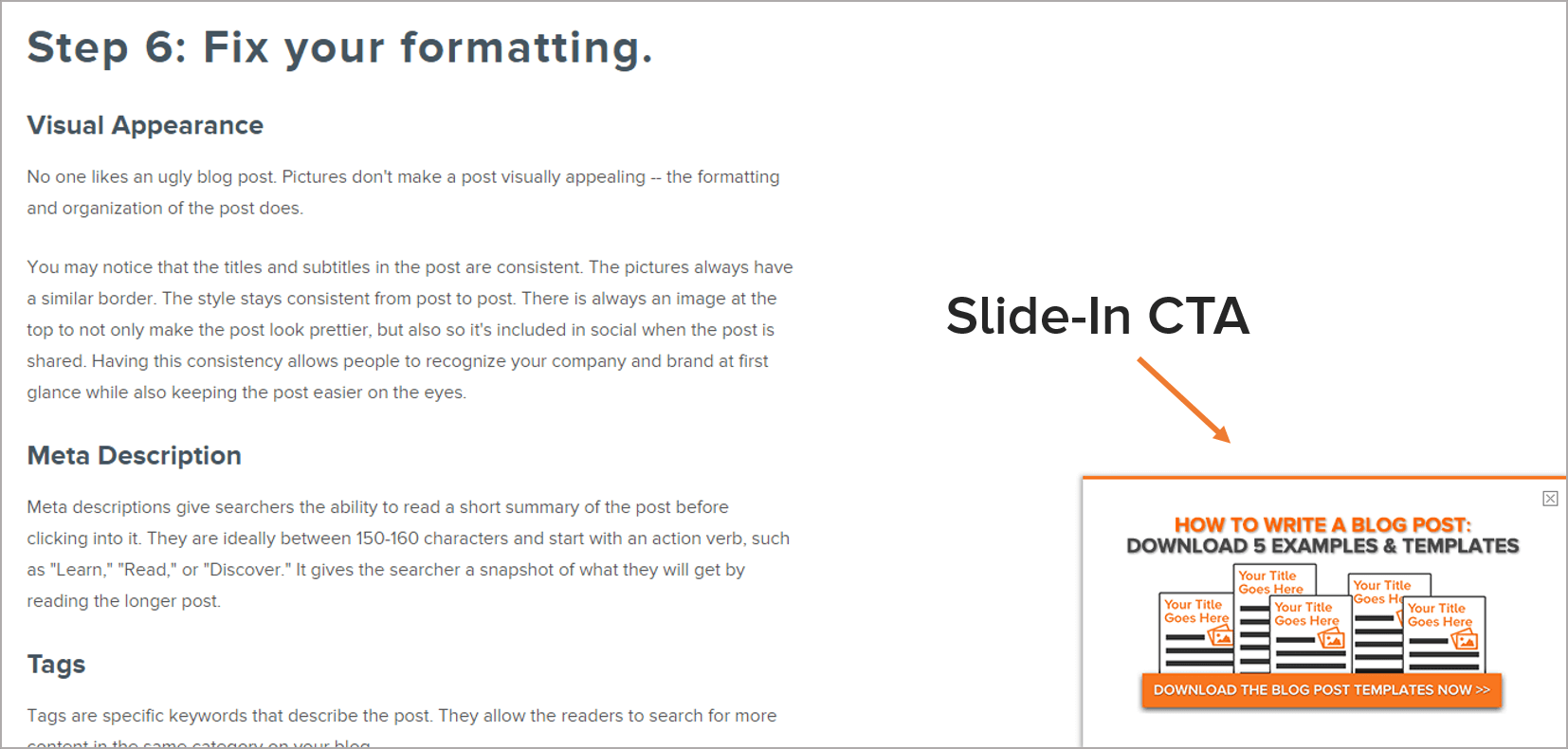
Result: Implement a slide in CTA to increase email opt-ins by 27%.
A less disruptive alternative to popup windows, slide in CTAs appear at the bottom right/left of your page as visitors scroll down your post.
This CTA should also include a tangible offer that is relevant to the article, such as an ebook, whitepaper, or webinar.
Here’s a step-by-step guide to set up a slide in CTA for your website.
13. Give Donors Something Tangible Like A Thank You Gift
Result: Enhance the giving experience by providing donors with a thank you gift.
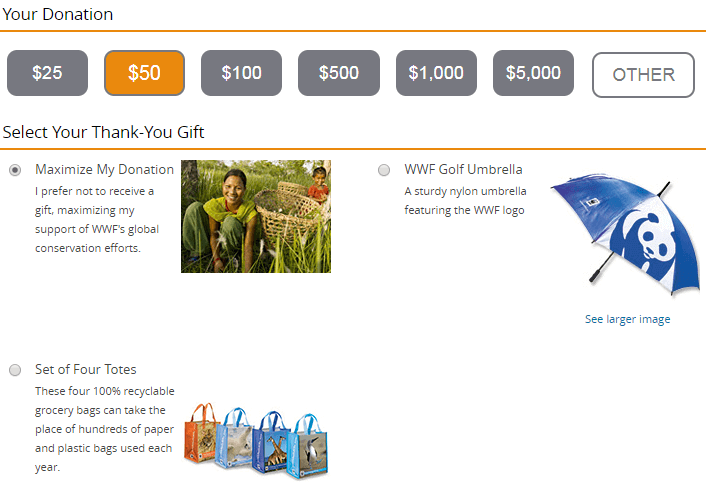
First, try giving something that aligns with your mission.
For example, a conservation organization might provide a reusable water bottle or tote bags.
Next, use branded gifts to expand awareness and reach of your mission.
You can also maximize your donations by providing an option for donors to opt out of receiving a gift.
If your organization is member based or has gated content, try giving away a 2-week free trial.
You could take this one step further by sending a thank you email to the donor.
In it, you should not only thank them for their conversation but also invite them to your community.
For example, a private Facebook group where you engage with donors and share stories and information.
14. Let Donors Choose How Their Donation Is Used
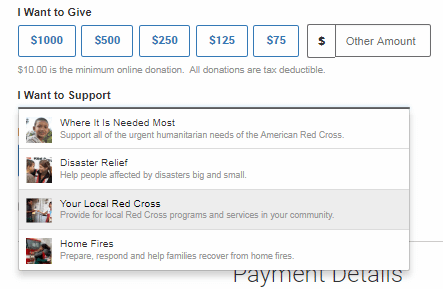
Result: Give donors the ability to choose where their gift will make an impact.
On your donation page include a drop-down menu with pre-selected options.
Note: Restrict donation options to no more than 3-5 to keep visitors from feeling overwhelmed.
Use different types of offers to convert diverse visitors.
15. Mobile Optimize Your Site
Result: Tap into the 25% of online donations occur on mobile devices.
10 years ago the technology of a cell phone an mobile data plans were limited – and expensive.
Today, you can live stream movies from a 4G network in 1080p with no delay or downtime.
As a result, people have found themselves increasingly spending their otherwise idle time on the phone.
Next time you’re at the grocery store take a look at how many people are face down in their phones while they wait in line.
This means the demand for having a fast and easy to navigate mobile experience is required and no longer a luxury.
Unoptimized sites also look unprofessional and cause visitors to leave your site.
The same goes for your mobile donation pages.
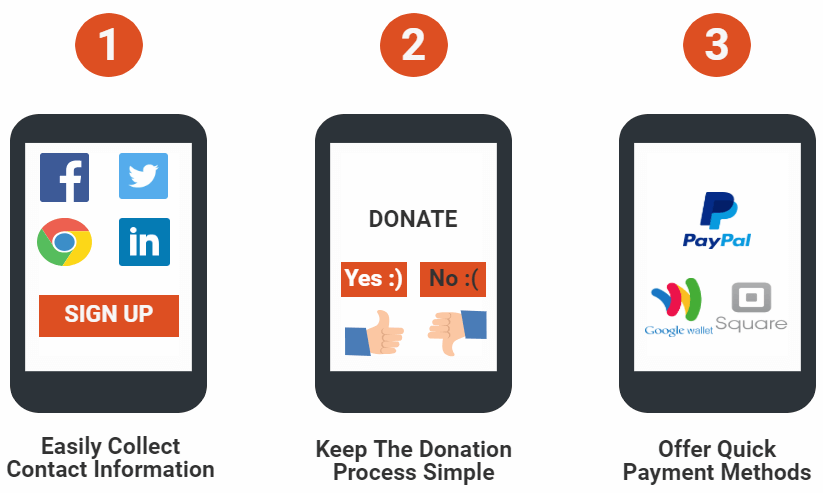
Don’t ask for too much information, as long forms are difficult to complete on mobile devices.
The goal is to make the mobile donation process as simple as possible as not to cause potential donors from leaving before they give.
Check to see if your website is mobile optimized.

Now I’ve got a question for you… Are you ready to give one of these online fundraising ideas a shot?
Taking advantage of even one of these fundraising ideas can make a huge impact for your nonprofit, skyrocketing your donations, membership sign-ups, and awareness of your brand.
Let us know which fundraising strategy you plan on using by leaving a comment down below!

Free Step-by-Step Checklist:
Which one of these 14 strategies will you use to grow your organization online?
Related Articles:
- How To Get More Online Donations With Content Marketing
- Online Fundraising Strategies: Nonprofit Marketing Link Roundup
- Master These Email Marketing Strategies For Fundraising Success
- 5 Tips For Steering Your Organization Toward Online Fundraising
- How To Get Started With Mobile Giving To Reach Fundraising Goals

